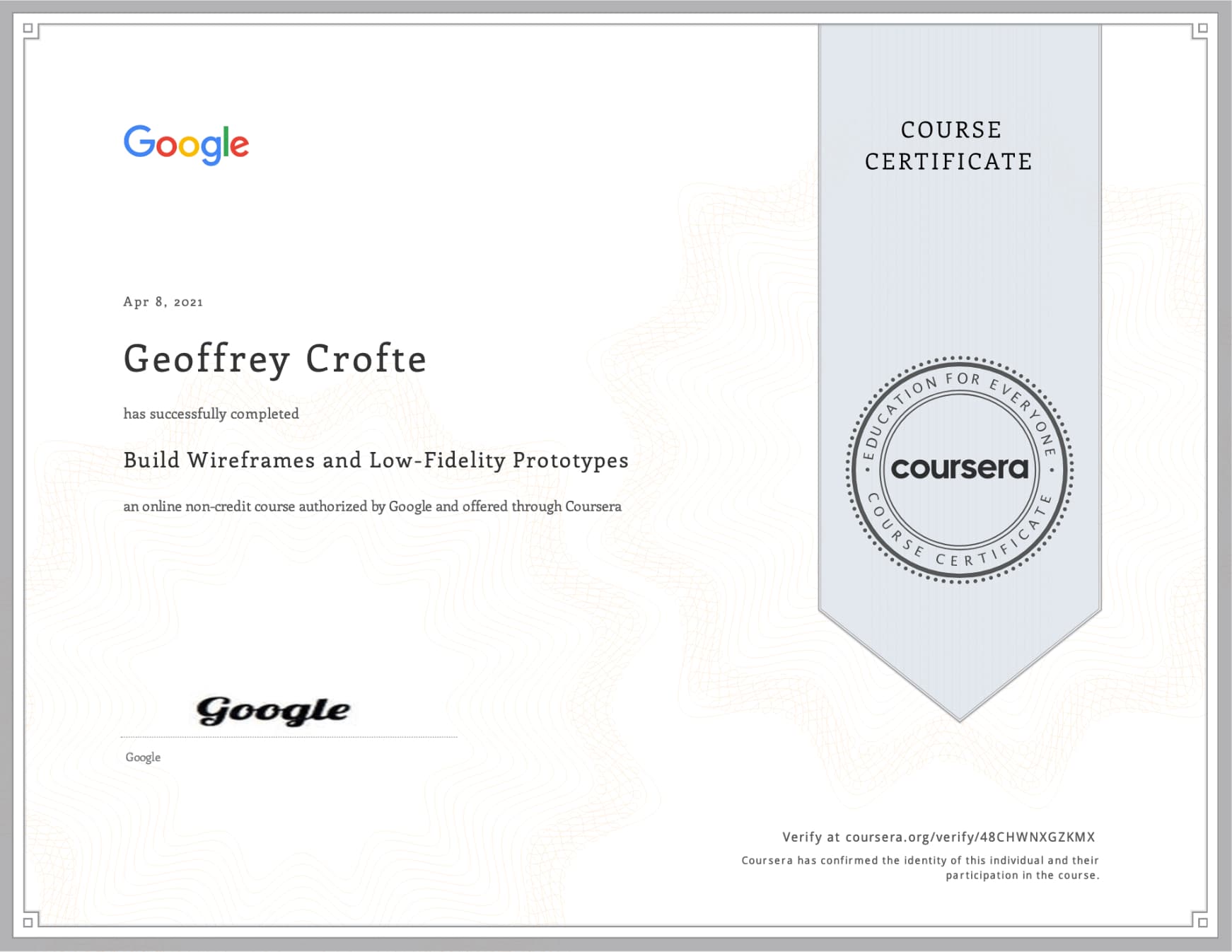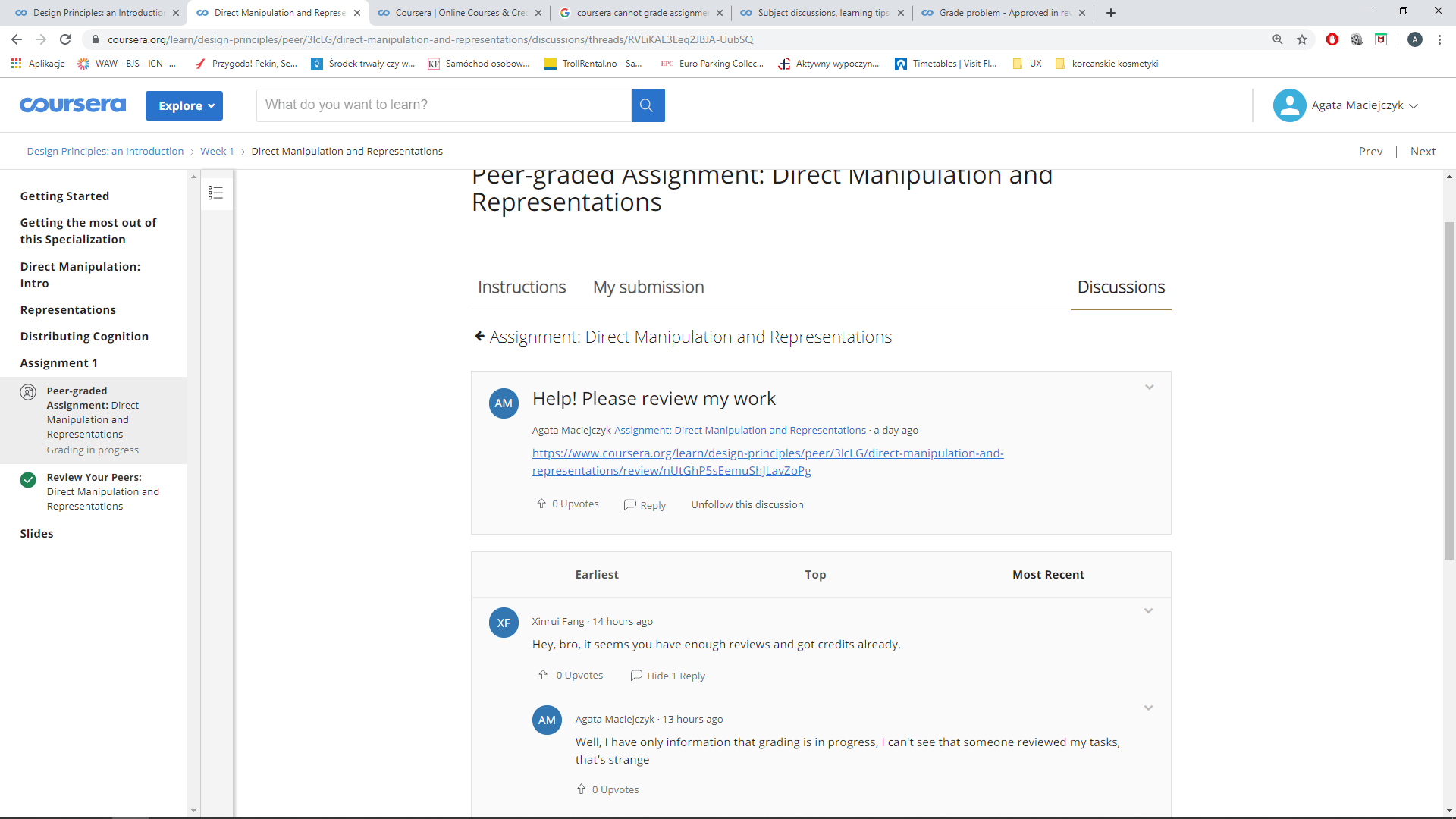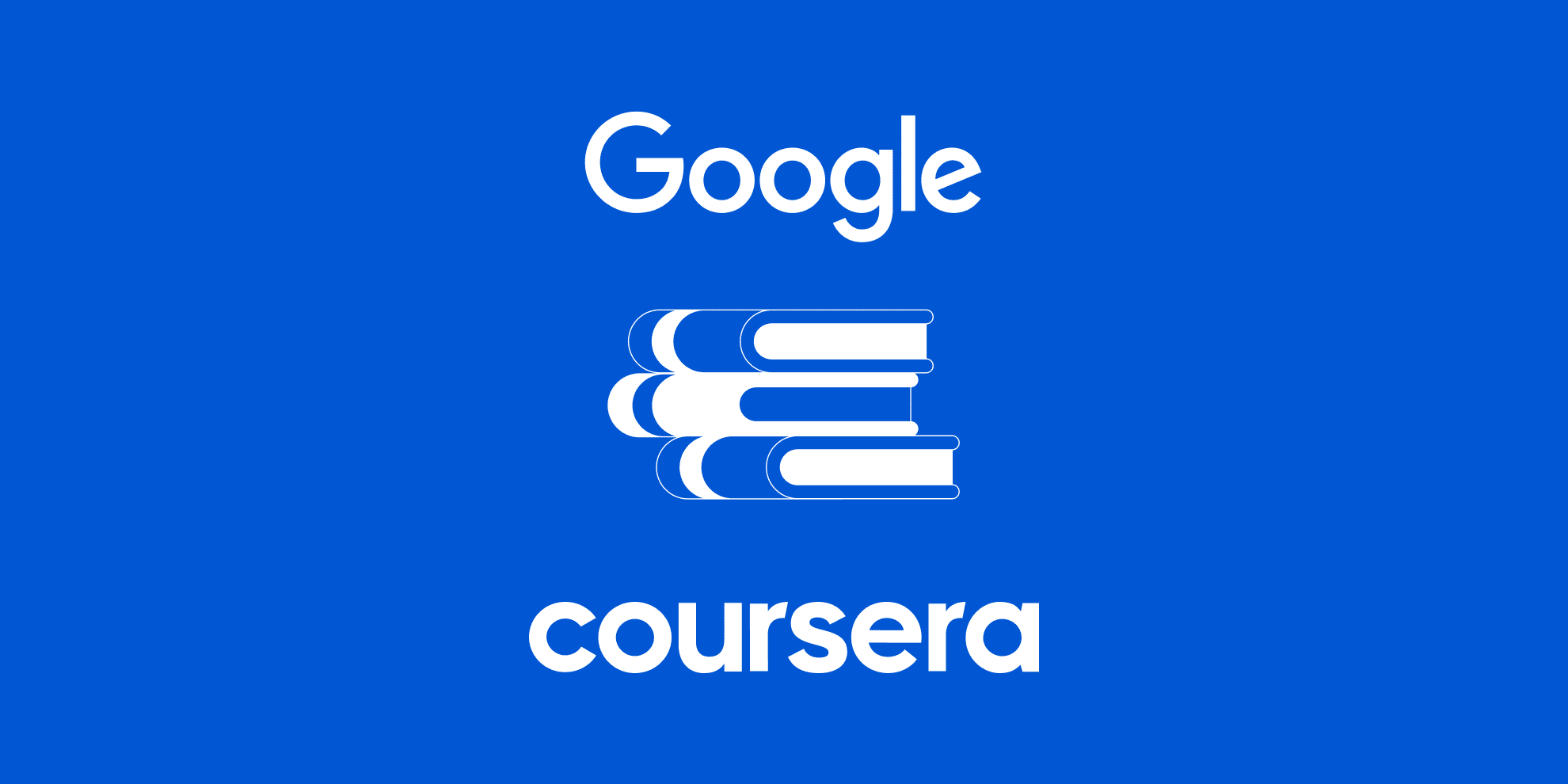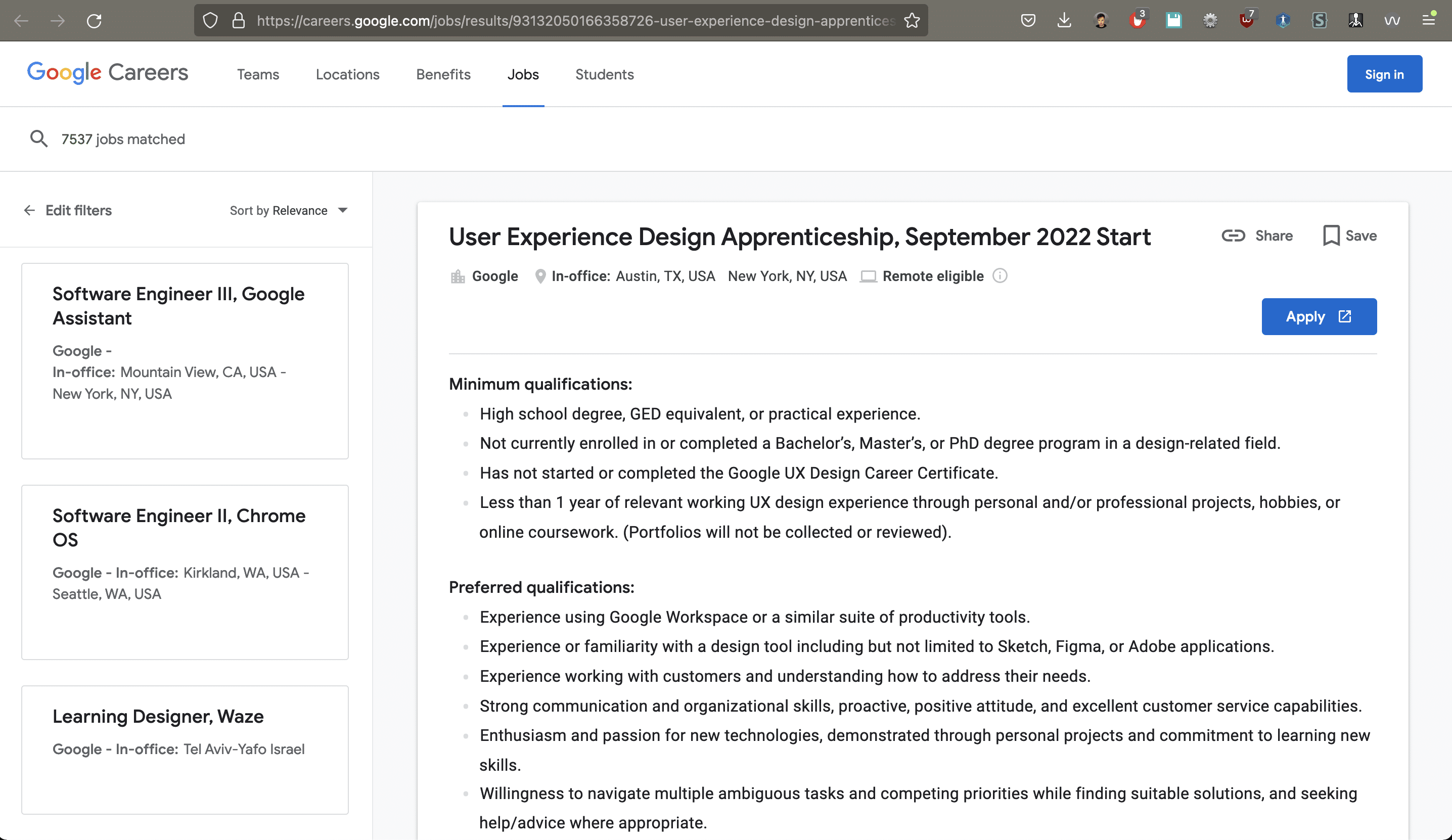Also available in: Français
The Google UX Design Certificate makes a lot of noise recently. It’s always good to see more kinds of training in our industry. But the real question I was asking myself was: is it really worth it? Well, I enrolled in this course to give you feedback as a professional in UX Design.
Article table of content
To be fair on my approach and to help you better evaluate my feedback, here is a bit of context around “me taking this course”, how, why, what, etc. Because context always matters in UX Design 😀
A bit of context around the Google UX Design Certificate courses
Context always matters, that should be the first lesson in every single UX Design Course in the world. And not only UX Design…
Why I took the Google UX Design Coursera course
I enrolled to this course for different reasons, and the first one wasn’t to give you feedback, to be honest. I’m building my own UI Course (not a UX one at the moment), and I was curious to see how other teachers are doing it online. When I read the name of Google on this UX Design Certificate, I told myself “how can you be wrong taking this course”, right?
The second reason is called impostor syndrome -yup, this little guy again. As I’m fully self-taught from the beginning of my career to now, I wanted to check my level of knowledge. In the process, maybe I might also get some good professional reminders that you tend to forget whilst practising the job, and maybe learn a few things I missed in my self-training.
The last reason is that the course was really new and proposed some shiny papers, also called certificates, that are verified. Some companies keep asking for these, and as I’m self-taught, I have no diplomas. So I told myself “why not” 👊
And for the people thinking that I could be a simple detractor, here are the first, second, and third course certifications. I put the time into this before writing these lines.

My professional experience and courses I took?
It’s important that you keep in mind that I didn’t take the whole 7 courses because I couldn’t keep wasting my time on it after the 4th. But I did take these in the right order from 1 to 4.
As a professional since 2008, I had a lot of different roles in the industry: front and back-end developer, WordPress developer, project manager, UI and UX Designer, and for many shapes of companies: web agencies, startups, private companies, small and big, and even as a freelancer. Today, I work for the first insurance company in Luxembourg as Lead System Designer and UX Designer, and I’m also a writer, mentor, teacher, and speaker.
I do a lot of technical and design watch to always challenge myself and improve my techniques and methods. That’s how I do and like my job 😁
So yeah, I’m not new to the industry.
How this Google UX Design Certificate is composed?
This professional certificate is made of 7 courses from 3 to 5 “weeks” each. Coursera call “a week” what they want you to take your time to realize in 1 week. It’s a pace they want to give you with a notification system, etc. It’s also, in theory, the time you need to realize the different exercises you will have all along your journey. But I’ll get back to it 😜
So you have 7 courses that cover:
- Foundations of User Experience (UX) Design
- Start the UX Design Process: Empathize, Define, and Ideate
- Build Wireframes and Low-Fidelity Prototypes
- Conduct UX Research and Test Early Concepts
- Create High-Fidelity Designs and Prototypes in Figma
- Responsive Web Design in Adobe XD
- Design a User Experience for Social Good & Prepare for Jobs
At this point, when you know nothing about the industry, this program feels right. But even there, as a professional, there are a lot of issues and questions already. I’ll get there in a moment, but before that, let me explain what to expect in terms of content.
The types of content of this Google UX Design Certificate
Coursera is maintaining a platform that offers several types of learning content to help the teachers. In this course, Google is using these specific ones:
- Short video course: they are from 3 to 9 min duration with one person talking, and sometimes showing you stuff. Good thing: transcription.
- A long page of reading that sends you sometimes to other online articles (with a lot of UX Collective articles on Medium)
- Shot page of reading with links to external readings, again.
- Self-evaluated exercises.
- Self-reflection on these exercises. (a form you must fill with at least 1 character, but it’s optional)
- Embedded polls or forms, or presentations you must read and validate in a way or another,
- Peer-reviewed exercises.
And if I’m not mistaken, that’s almost it.
Let’s talk a little bit about the things that really matter now, in my opinion: all the issues about this certificate.
Issues with Coursera platform
Coursera is a learning platform that exists since 2012 and has been created by 2 professors of Stanford University computer science. During the pandemic, Coursera and other platforms like Google and Udemy sponsored over 115 specialized certification courses for students, stakeholders, and persons who may have been affected by the global pandemic.
Despite all the goodwill of offering a great platform to learn and grow skills, Coursera is full of UI and UX flaws here and there that make the learning experience (LX) debatable.
Madalina talks about the peer-review and the self-reflection part, here is her feedback about it. But let me share with you my own experience and point of view.
The principle and issues of the peer-review
When you read the advantages of taking a course on the platform, you read something like “Graded quizzes and assignments“. I don’t know for you if you took this course, but I didn’t see any graded assignments.
Instead, there is this concept of peer-review.
Peer review is made by actual peers, not by professionals. The feedback you’ll get, if you get some, will be from people with the same level as you. Personally, I didn’t get any feedback on my work, just random evaluations. I had someone giving me an 80/100 evaluation while respecting all the strict criteria of the evaluations, and someone giving me a 100/100 while doing half of the job (on purpose).
Moreover, students are not teachers, they are not trained to do the evaluation of other students based on skills and knowledge they are supposed not to have, yet.
Coursera biased peer-review: racism, sexism, etc.
Another big issue that I really don’t understand is the even essence of the platform: you can see the name of the person you are about to review.
Why? In what world do you need the name of someone to appreciate their skills and competencies?
You can see the name next to the work you are evaluating, and you can also see the name of the students in the discussion forums. Just to be sure you don’t miss it.

Once you have the student’s name, it’s open door to racism, sexism, and all the bad words ending with “ism”. From a course that teaches you implicit bias (test your implicit bias), it’s a total shame.
Peer-review and self-reflection discussions
As you can see on the above screenshot, a discussion forum is available for each self-reflection or peer-review session. This is supposed to be made to help people have discussions about what they have learned, what were their difficulties, and learn from each other. That’s a great thing.
Unfortunately, people being people only there to rush and get their “golden paper” (the certification) are posting the link of their work asking to be reviewed in the peer-review forum, and on the self-reflection, people are literally posting one word, one sentence, or sometimes just a “.” or a “-“. Maybe it’s supposed to represent the emptiness of their brain, or maybe they can’t self-reflect? I’m not sure about that. But in many cases, these forums are full of emptiness and uselessness.
It’s sad because it makes the only moment where you are in interaction with other learners totally useless and doesn’t help you, as a learner, to grow with others. And trust me, there is nothing more encouraging than discussing a course and skills learned with other learners: you meet a new vision of the course, new understanding, and different cultures.
The global usability
I won’t go into lots of details here. But Coursera is sometimes a pain in the ass to use. There is even a case detailed on Suggest.design for Coursera. It’s one among so many others.
First, if you are on Android and you are using the app, or the website, you won’t be able to write into textarea fields because their JavaScript is messing with your virtual keyboard. When I was writing “I think that the…” their script inversed the letters “eht taht kniht I”, ok, deal with that. I sent a support request, but never had an answer from Coursera.
You also have sometimes embedded content like quizzes or other kinds of exercises. The embed content has a so bad design that you can do the exercise entirely and forgot to validate your result and jump by mistake to the next part of the course. Why can I click next if the exercise is mandatory? Why do I need to double-validate, one time on the embedded content, and one time outside of it?
I mean, this is not a Google UX Design Certificate issue, I agree, but if Google validated this platform to put a UX Certificate on it, it’s because they think the platform is good, right? Or did they?
It’s not like Google hasn’t the money to build its own learning platform. Come on…
Issues with the content of the UX Design course
I gave you the course plan earlier. Let’s get through it quickly.
When short is too short
It’s a cycle of 3 to 5 min videos to introduce a topic, a lot of reading on the Coursera platform, and more reading on the internet with lots of articles from UX Collective on Medium. Some interviews of professionals, exercises you can literally skip, like the rest by the way, and peer reviews that are total bullshit because nobody is actually reviewing your work.
The videos introducing some topics are too short, and not in-depth enough on some topics that are the essence of design, like inclusive design, accessibility, or actual user research, the part where you get to know your users is, to me, totally missing.
Where is the research in the Google UX Design world?
You are asked to build personas based on questions you asked potential users: nobody helps you to recruit the users, the example they give is not a recruitment process but a bottle in the sea. They tell you about diversity in the panel of users, but nobody gives you advice on how to actually recruit these people to avoid you falling into bad habits, etc., etc.
And, even on the research part, they don’t give tips on how to do decent research when you don’t have direct access to users. I mean :
We forget that too easily, but: having access to end-users is a privilege that not all designers have.
What do I do as a beginner if I don’t have access to end-users? Please Google, tell me, you are the teacher and expert here, aren’t you?
What I would expect as a beginner in the field from a UX Design Course
I teach and mentor a lot of students and people who are taking the path of UX Design or are curious about it. And the questions are oftentimes the same with more or fewer variants.
- How do research when I can’t access users?
Because I really need to remind you that in some industries, having access to the end-users is a privilege that a lot of designers don’t share. - How to do with a low budget on design?
Yeah Google, we are not all Google with infinite budgets. So, what are the solutions that allow me to do proper research without having to ask for a budget for the design part when companies are dev-oriented? - I can’t use Figma or XD, how can I do?
That also. Some industries can’t allow cloud systems because of the legal aspects of their data. Sometimes it’s not the industry, but the entire country. What are the existing solutions? - How to work with marketing, developers?
You don’t work as a designer for your own will and wishes, at some points you’ll need to communicate with other teams within the company: marketing, developers, communication, legal people, security people, etc. How and when should I do that? - How to speak to my hierarchy to make my ideas validated?
Sometimes, you need to prove that you are not a terrorist inside your own company because it’s well known: designers have this bad habit to change other people’s habits. How can I show my hierarchy I’m here to help both the users and the company interests?
Meanwhile, I fucking don’t care to learn during 3 courses of your certification how to use Figma and XD tools. Tools are tools, they are made to change in our industry. People can learn that by themselves or find tons of tutorials online.
Google, you should’ve answered all of these questions instead of teaching tools. Really. 👍
Issues with the “Google UX Design Certificate” and Google’s name on it
When we talk about biases, the name of Google over any content on the internet brings a lot of them. And that’s a big issue to me.
The Google name on it
The Google name on this course is a real issue. The first you’ll notice is the number of people taking it and showing off their certificate on LinkedIn and elsewhere.
It’s an issue indeed because people are expecting to have a certain level of quality. It’s Google after all. Or, they might think it’s good enough to be at the “Google level”, whatever that means in our industry. I’m talking about both the companies who hear about it, but also the learners and future learners.
Companies that support this course also made a deal to hire people with this certification, if I did understand well. But that’s a double loss in my opinion because:
- these companies think they will be able to do things like Google, stealing a bit of their “industrial sauce”, if I can call it that way,
- and learners, on the other hand, might think they will be able to handle UX the same way they do at Google.
But these are lies, necessarily:
You cannot copy a way of working in a company and paste it into another company. It doesn’t work that way.
Last note on this topic, and that’s a more direct message to all the people telling the world they are “Google UX Certified”: no, you are not! Google doesn’t have your back. This is not a Google certification, this is a certification given by Coursera, for a course that Google offers, for free. Nothing more. So, sorry not sorry, you are not Google Certified.
But Google Certifications are a totally another topic I won’t explore here.
Edit on 8th may 2022: Google even ask people with this certificate not to apply on this job application.
In case the page is removed, here is a screenshot saying that to apply for this offer, the candidate: “Has not started or completed the Google UX Design Career Certificate”
Of course, this means nothing. Regarding the previous bullet point, it’s certainly more for having the ability to train the person on their own. But still, you get my point I suppose 😉
The course qualifications: you are not getting those skills…
This course isn’t for a beginner level or entry-level. Once you took this course, you will have absolutely no skills for the job. To stand it in other words:
The Google UX Design Certificate doesn’t prepare you for a UX Design beginner role.
Of course, this course doesn’t qualify for a job. Let’s face it: there is absolutely no expert validation in that process. It’s like nobody wants to take responsibility for this course: Google teaches it but there is no evaluation made by them, Coursera is providing the platform, but they don’t want to improve their well-known issues about the peer-review feature, or their global learning experience.
The only moment you are being reviewed by someone, this someone is a human being like you, with supposedly no more experience than you do have. You can’t be qualified with absolutely no feedback, no mistakes pointed out.
How would you improve yourself, learn new skills, or know if you completed the exercises doing the right thing if no expert is telling you so?
I mean, I had people in the peer-review sessions, submitting the examples given by Google as their own work, hoping that nobody will see it. Unfortunately for them, they had me as a reviewer so I sacked them off. But, let’s suppose this kind of person passes all the exams, lucky them, what does that mean for the people who really did work hard on this? This certification would have, or maybe already has absolutely no value because of this messed-up system, and the idiots rushing it. (sorry not sorry)
It’s not entirely the system’s fault, it’s also because of the participants themselves that this certification doesn’t have any value.
Google UX Design Certificate: who is this for?
In my opinion, this course can be useful for people who are curious about this professional domain, for people whose job isn’t and won’t be UX Design. I am thinking about recruiters, HR people, or UI Designers or developers that are curious about this job and want to better know it by practicing a little bit in their spare time.
That’s all. That is the target of this course in my opinion.
Other professional opinions on this Google UX Design Certificate, in a podcast
Debbie from Delta CX, a well-known expert in the industry, invited 3 learners from this certificate to get our feedback on it. Learn from other people than me in this video podcast.
Thanks again Debbie for the invite, it was really fun and this even motivated this article 😊
I really hope this article will save you a bit of your precious time.
Frequently Asked Questions
I had a lot of questions after the publication of this article, and I thank you for your interest in this matter. I’ll try to answer the most common ones, but don’t hesitate to reach me on Twitter if you have any more questions.
Can I get a job with Google UX Design Certificate?
The answer is yes, if you do your own training and reading and practicing in addition to it; and no at the same time. The Google UX Design Certificate doesn’t qualify you for the job for many reasons mentioned in this article: someone from Google admitted it (watch the video), the peer-review of the training is not done by professional people or experts, the research part is totally “BS”, and the practice can be skipped while it’s the most important part in UX Design.
How much will the Google UX Design Certificate cost?
At the moment, this course is Free, but to access the certificate you need to pay at least a month of Coursera: $39 USD. By rushing the course, you can do it in 2 months, so it will cost you less than $80. Google proposes a pace that makes the course lasts 4 to 6 months, so it’s $240 maximum. It will cost you a lot of time though…
How long does the Google UX design course take?
It depends on the time you can invest. Google and Coursera propose 7 courses of 3 to 5 weeks. It’s about 4 to 6 months long on the pace they propose, but with a good investment in time, you can do it in 2 months.
How long does it take to get a UX Design certification?
Well, that’s a good question. Regarding the industry and the skills you need to gather to practice proper UX Research and UX Design, I would say that a course or training made in less than 6 months is not a good UX Design training. But it really depends on the program of this course or training. An intensive 4 months of practicing UX Research and Design is better than 8 months doing theoretical courses. You can get a certification in 3 weeks if you just need the document… 😉
Does UX Design require coding?
Nope! It doesn’t, but -there is always a but- knowing how coding is handled by your colleagues or collaborators is always a good thing. A bit like all the skills and knowledge close to your domain of practice: legal, security, development (coding), performance, marketing, psychology, etc.
Is the Google UX Design Certificate worth it?
Well I think this article answers the question. But in short: no. But it’s my professional opinion based on the experience I had in 2 different countries, in web agency, startup and now practicing UX design in a big insurance company. The way Google is doing UX Design is not applicable in most companies I’ve known. Unfortunately, Google is teaching UX Design like Google would do it for Google in Google projects…







Hey there. I read your article, I am currently doing this course because I thought it would help me get my foot in the door. I’ve been working really hard on it, I do agree with you about the peer reviews and the Coursera platform, but is all hope REALLY lost when putting all this effort into learning tools they show (i.e. Figma) when it comes to landing an entry level UX job? I really want to do visual or interaction, but I have no degree just 10 years of customer service, retail management experience and I have my own gifting blog site. Is it really not worth it?
Hello Anyssa,
Thank you for your comment and time to write this, and sorry for the delay of my answer.
The industry as it is nowadays is full of self-made people, because some years ago there were no training, courses and bootcamps about UX Design. You were signing on a University branch like Sociology, Psychology, Human Science, or HCI-related paths. You had like 3 to 5 years minimum of study to get a diploma, and maybe a job in the end.
Now we have bootcamps and MOOC that propose a certification with 3 weeks of effort and learning. But in parallel, our industry has become more and more complex and specialized. How can we compress 3 to 5 years in the university in 3 weeks to 4 months of MOOC without any expert to review your work?
That’s a real question everybody should ask themself before signing up this kind of course.
But, as I said, our industry is full of self-made expert, because we did have certifications, or program, or university specialized in UX Design when we started. So we’ve learned by ourselves. So yeah, of course you can learn it, and of course the time you spent in it will not be in vain. Plus, who am I to judge every one of the students taking this certification? I’m just pointing out all the issues around it, and wanted to tell that: nope, this certification isn’t valid for our industry, only the things you’ll learn by yourselves are, because the thing that matters isn’t the piece of paper at the end, but all the effort and things you’ll learn by trying to get this piece of paper.
If you are rushing it for the paper, you’ll learn nothing. (not you especially, in general)
I’m sure you are doing it great, and your effort in it will pay in the future. All good luck for you Anyssa 🙂
What would you suggest for someone trying to break into the UX Design world if not this course? I’m in the US.
Hello there,
Without more information on your own path and experience, I would say this:
https://www.azent.com/expert-tips/ms-hci-us
or any kind of guided professional training that includes several internships and mentors in the process.
If a professional training doesn’t offer a network, internships, and real expert feedback, it’s a bad training in general.
What do you suggest for someone trying to break into the UX Design if not this course?
Hello,
This 🙂
Hi Geoffrey,
Thank you for this detail review. I was deciding on paying for Google UX or self-taught.
I am doing a PhD focus on construction supply chain, I also have industry experiences. I was hoping to use IU/UX as a research method but also hope to have the opportunity to continue after my studies as a UX researcher. I learnt that its best to learn and understand UX design with research because I may work for a company who doesn’t have a designer and need to do but research and design.
I have downloaded several different papers focus all the different UX research methods, I was going to build my portfolio of the different methods via my PhD research.
Am I going to long way round?
Hello Nkechi,
I think you are doing it right, to me. I mean, that’s how I would to it too.
But regarding your experience and the steps you already went through, I have the feeling that you already know a lot thanks to the papers on UX research methods, and UX Design Google Certificate would be a waste of your time.
But if you can spend some hours on the first courses and in analyzing the course plan, maybe you would have a better idea on either you want to do it or not 😊
I prefer when people are their own judge in the matter 😁 This article is mostly to point all the defects of Coursera, the Google name/trend around this and the skills validation process that is totally lacking.
I hope I could help,
Have a good day
Hello Geoffrey,
What Online Courses would you recommend to get started in UI/UX?
Hello Alejandro,
Oftentimes, you’ll find courses at a country level in social science, or psychology.
Some private organizations in France give qualitative training online, you have a dedicated mentor, at least 6 months of daily work, internship, professional evaluations, etc.
I can’t tell for your case, but with these mentioned criteria should be a good start to find one 🙂
1. You did not finish this course, so your opinions are not valid.
2. You obviously do not understand the concept of peer-reviewing. I did my PhD and articles for publications are peer-reviewed (by other PhD candidates). I did a medical degree with peer-reviewing by other medical students. so based on your daft logic, both my PhD and medical degree are not valid???
3. You are obviously a novice in the industry and yes as you pointed out yourself, an ‘impostor’.
4. You have caused at least one of my student to lose a job opportunity, because the interviewer relied on your worthless review to downplay his UX knowledge although my student had a CS degree from NUS!
5. keep your silly opinions to yourself and remove this post or else, in 48 hours you will be reported to google and further actions befitting your malicious comments will taken against you!
Thank you for your time and comment.
Unfortunately, the web is an open area where everybody can give their own opinion. And as I mentioned, this is my own opinion as a professional.
I’m sorry for your student, sincerely, but if someone relied on my worthless review, it’s maybe because this person shared a common analysis and vision of the UX industry, not only because of me, you give me too much importance.
Or maybe your student didn’t have a clear understanding of the industry to defend themself. This would confirm that this certificate doesn’t give a sufficient foundation.
Finally, maybe it’s better for your student not to work for someone who would trust an impostor with a worthless opinion.
I totally understand the principle of peer-review, and unless you used Coursera to get your PhD, I have never criticized this way of evaluation, but several aspects of the one offered on Coursera, please take more time to read what I wrote before being so aggressive.
Finally, on the biased aspect of not finishing the course, well, I perfectly know the end of this course because it’s only hours of discovering tools I already know.
Now, take time to check your own biases and reflect on your behaviour.
Have a great day.
PS. I don’t care about Google, because I write for people.
PPS. Remember your student is YOUR student, but I never mentioned their failure could be yours. Because I don’t know you, and you don’t know me.
Hi Geoffrey, I read your article and I think you are right. I took the Google course but never finish it because I feel like I was learning nothing. I’m planning to start a bootcamp here where I live but I don’t know If is it worth it to pay $15,000. I mean obviously is worth it if it cost that much but nobody wants to pay that amount for a bootcamp so my question is do you thing I should take it?
Hello Rachel,
Thank you for your feedback on the course, and for completing my article with it. Always good to have different people’s opinions.
I usually don’t recommend Bootcamps, because knowledge comes with time, and, unless it’s a 3 or 4 years BootCamp, $15,000 or $500 won’t bring your more knowledge.
Also, pricing for learning (university, course, BootCamp) really depends on the country you are living in. I tend to say that $5000 for a 3-week BootCamp is kinda ok because in France the day for continuous professional training is 500€/day.
I can’t tell you to do, or not to do it, you need to compare and do the calculation. If they propose a network, professional review, and companies to work with at the end of the process, and you can afford it, maybe it is worth it.
I can propose you watch this https://www.youtube.com/watch?v=1-ibRRQKJ2I and document yourself on feedback from people who did this Bootcamp you would like to do.
Good luck on the UX Design path Rachel 🙂
Hi Geoffrey!
I have 10+ years of work experience as a web content editor/writer/marketer and have managed teams in these areas. My first job out of grad school (I studied journalism) was as a junior business analyst for an IT firm and I fell in love with UX design. I spoke with designers, shadowed one really nice UX designer, and read “Don’t Make Me Think” at their urging. Also, in my role, I worked on wire-framing (for web and mobile), user profiles, and in agile methodology (which I love). However, my career path took me down the editorial route for so many years after that but now I’m finally ready to dive back into UX. I was going to take this Google UX Design course, but came across your article and am now second-guessing that decision. My goal is to build a portfolio to showcase what I can do and I thought a course like this would refresh me on the things I already know while allowing me to build a professional portfolio to showcase so I can start applying for jobs. (I also recently lost my job so I have time haha). What do you think? Are there better courses for these goals? Thank you!
Hello Anna,
That’s a fair question and I thank you for asking.
After reading your comment, it looks like you have a (maybe first) goal of building a portfolio. This course makes you work on 2 projects of your choice, allowing you to showcase some shiny deliverables by focusing on a partial design process.
If you already know the industry from past experience, you can use the time you have to focus on these specific points to help you build a portfolio and take the turn toward the UX industry 🙂
Your most challenging exercise will be to find a good app subject to follow this course. 😁
I wish you the best!
Hello Geoffrey,
I’m 24 years old and just made a big life decision. I quit nursing school after 3 years and decided to pursue UX design instead. There is so much information every where and not a straight how to that I don’t know how to move forward. I will be completing an associate in science soon and am working on the google course for both data analyst and UX design. Can you give me some advice on what I should do? What courses I should take, degree to pursue, learning for this field?
Congratulations on making this big life decision and pursuing a career in UX design! It’s great to read and inspiring.
As for your question on what courses to take or degree to pursue, it really depends on the country you live in, the resources in time and money you have, and your specific career goals in the field of UX design. There are many different courses and degree programs available that can provide valuable skills and knowledge for a career in UX design.
However, as a general rule of thumb, and to illustrate the difficulty of giving your advice here, a good start for a UI designer would be to focus on graphic design and human-interaction courses. For UX research, courses in sociology and ergonomics would be beneficial. It really depends on the goals you want to reach with the combination of data analyst and UX design skills. In addition to these foundational courses, it’s also important to gain practical experience through internships or working on real projects. It can even change the way you see the industry and gives you more opportunities.
I apologize that I can’t provide more specific advice on courses and degrees to pursue since I don’t have a comprehensive understanding of all the training available in the world. However, I hope this advice can serve as a good starting point for your journey. Don’t hesitate if you have more specific questions. Best of luck to you!
I don’t think that this course is good for somebody without any prior design experience, but as a motion graphics designer with college degree and 10+ years experience, I managed to get an oversight of the ux design and with a couple of tutorials, even managed to learn the technical part too without having to walk in a learning facility, spending months on classes to learn the same stuff. Ux is not so complicated as many would think and the course is enough to get started in the industry IF you have some previous graphic design experience. And I do think that the course offers plenty of insight into the “secret google sauce”, it s enough to get their method, you can study their design system, way of thinking etc. Although I don’t think that google is a good example but for many companies, it is considered the example to follow until they realise that it costs money to do so.
I am reading this article and then the comments and I find myself kinda smacking my head in disbelief. So many complaints about how to conduct interviews and whining about Figma and other stuff. For Pete’s sake, initiative is a wonderful thing. Go out and talk to people you think might be good candidates for user testing. Figma has a free account, but if you are presently working as a UX designer, then why on earth would you not pay for the paid version? I’m still a student and I have a paid Figma account, because I see it as an investment in my future. You get out what you put in with these courses. I am also currently in a online UX Bootcamp offered through the UC University system (a very tough program) and there are plusses and minuses to each. You cannot expect someone to hold your hand through the whole thing. Most times, you can just figure it out as you go. As to whether or not the certificate is worth it? Again, I go back to: you get out what your willing to put into it.
Hello Ashley,
thank you so much for your time and comment.
I completely agree with you. The value of a certification is not in its name, but rather in the effort that you put into understanding and practicing the concepts. It’s great to see that you are taking the initiative to invest in your future by paying for a Figma account and participating in an online UX Bootcamp. It’s important to remember that no one can hold your hand through the whole thing, and that figuring things out as you go is a valuable part of the learning process. Ultimately, the value of any certification or course is dependent on the effort and dedication that you put into it.
Good continuation to you 🙂